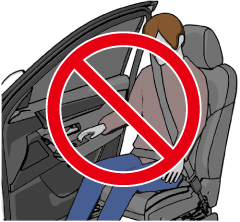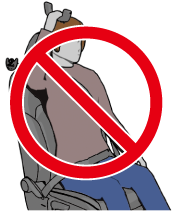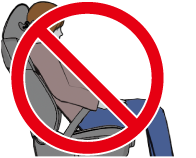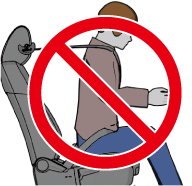

Warnings and Cautions for Using the Front Passenger Occupant Classification System
Do not decrease the total seated weight on the front passenger seat.
When an adult or large child sits on the front passenger seat, decreasing the total seated weight on the front passenger seat required for air bag deployment is dangerous. The front passenger seat weight sensors will detect the reduced total seated weight condition and the front passenger front and side air bags and knee air bags, and the seat belt pretensioner system will not deploy during an accident. The front passenger will not have the supplementary protection of the air bag, which could result in serious injury. Decreasing the total seated weight on the front passenger seat could result in an air bag not deploying under the following conditions, for example.
-
A front passenger is seated as shown in the following figure.




-
A rear passenger pushes up on the front passenger seat with their feet.
-
Luggage or other items placed under the front passenger seat or between the front passenger seat and driver seat that push up the front passenger seat bottom.
-
Any accessories which might decrease the total seated weight on the front passenger seat are attached to the front passenger seat.
The front passenger front and side air bags and knee air bags, and the seat belt pretensioner system will deactivate if the front passenger air bag deactivation indicator light illuminates.
Do not increase the total seated weight on the front passenger seat.
When an infant or small child sits on the front passenger seat, increasing the total seated weight on the front passenger seat is dangerous. The front passenger seat weight sensors will detect the increased total seated weight, which could result in the unexpected deployment of the front passenger front and side air bags and knee air bags, and seat belt pretensioner system in an accident and may cause serious injury. Increasing the total seated weight on the front passenger seat could result in the front passenger front and side air bags and knee air bags, and seat belt pretensioner system deployment in an accident under the following conditions, for example.
-
Luggage or other items are placed on the seat with the child in the child-restraint system.
-
A rear passenger or luggage push or pull down on the front passenger seatback.
-
A rear passenger steps on the front passenger seat rails with their feet.
-
Luggage or other items are placed on the seatback or hung on the head restraint.
-
Heavy items are placed in the seatback map pocket.
-
The seat is washed.
-
Liquids are spilled on the seat.
-
The front passenger seat is moved backward, pushing into luggage or other items placed behind it.
-
The front passenger seatback contacts the rear seat.
-
Luggage or other items are placed between the front passenger seat and driver seat.
-
Any accessories which might increase the total seated weight on the front passenger seat are attached to the front passenger seat.
-
To assure proper deployment of the front air bag and to prevent damage to the sensors in the front seat bottoms.
-
Do not place sharp objects on the front seat bottoms or leave heavy luggage on them.
-
Do not spill any liquids on the front seats or under the front seats.
-
-
To allow the sensors to function properly, always perform the following.
-
Adjust the front seats as far back as possible and always sit upright against the seatbacks with seat belts worn properly.
-
If you place your child on the front passenger seat, secure the child-restraint system properly and slide the front passenger seat as far back as possible (Search).
-


